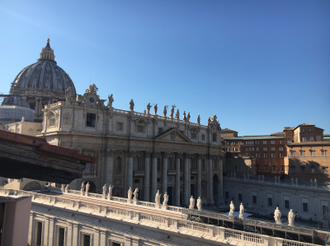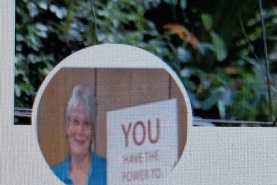Rome: The Church Up Close - Day 2

View from roof of CDF
Who would have thought our group of Catholic journalists would be admiring the wonderful view of St Peter's from the roof of next door's Congregation for the Doctrine of the Faith. Its stunning building and courtyard transported us back into the sixteenth century…. with a few flashbacks to the Inquisition. When we moved to the ground floor for a meeting, the room was the one in which Galileo had been tried! We were told that the CDF has been dedicated to "protecting the faith and morals of the Catholic Church" for more than 400 years.
But let me report on a talk there by Mgr Santiago Michael of the Pontifical Council for Inter-Religious Dialogue.
Many grassroots Catholics are not aware that the Church believes in respect for and dialogue with people of other faiths. Dating back to 1964 this Pontifical Council is the central office of the Catholic Church for promoting interreligious dialogue in accordance with the spirit of the Second Vatican Council, in particular the declaration Nostra Aetate.
Until his death in July, Cardinal Jean-Louis Tauran was president and warm tributes were paid to his commitment to this mission. Mgr Michael, who hails from India, conveyed a determination to support Pope Francis in his initiatives for collaboration with other faiths on Justice, Peace, and Ecology. He flagged up the Pope's trip to the Holy Land in May 2014, where he prayed for peace at the Wailing Wall of Jerusalem with Jewish and Muslim leaders. Also, the welcome Laudato Si has received from other faiths anxious to join with Pope Francis in protecting 'Our Common Home'.
The new World Day of Prayer for Care of Creation on 1 September, initiated by Pope Francis, has been taken up by other religions, as has the World Day of the Poor. Mgr Michael reported that Christian-Muslim Dialogue has been a priority for Pope Francis. The Pope encouraged meetings between the Pontifical Council and the al-Azhar University in Egypt, which led up to a February 2017 conference, 'The role of al-Azhar al Sharif and of the Vatican in countering the phenomenon of fanaticism, extremism and violence in the name of religion'.
We were told that Pope Francis' vision is to build "bridges of peace". He has reintegrated nonviolence into the heart of Catholic teaching on war and peace, has created initiatives reaching out to the poor and vulnerable, and invites all people of goodwill to care for one another and for creation. During the meeting Mgr Michael was told of grassroots initiatives of interreligious dialogue in England and Australia - known to the journalists - and he said that the Pontifical Council encourages this celebration of diversity at every level.
The Vatican reaches out to the world, but it is clear that the world comes to Rome. The tour of the day was of St Peter's, led by Fr John Wauck of the Holy Cross University, but first we joined people from around the globe and queued in the hot sun for security checks. One in our party had been in St Peter's Square when Pope John Paul was shot there in 1981 and recalled the silence and prayer that followed as he was whisked away. Fr John noted that the spot was in the shadow of the Square's 3,000 year-old obelisk, which had originally stood nearby in the Emperor Caligula's stadium where St Peter was martyred.
We admired the 15th century bronze doors (from the earlier basilica by Filarete) on the way into the great basilica and we all enjoyed the panel which showed the workmen celebrating finishing the doors and they left their names. Crowds were unknowingly walking over the ancient red porphery disc - upon which Charlemagne was crowned Holy Roman Emperor on Christmas Day 800. We were soon before Michaelangelo's stunningly beautiful Pieta, which he sculpted at the age of 24, and then noticed a surprising number of monuments to women, from Matilda of Canossa to Teresa of Avila to Veronica wiping the face of Jesus. Working through the crowds at the tombs of St John Paul II and St John XXIII we were at the high altar, built over the tomb of St Peter.
At the very back of the basilica was a luminous representation of the Holy Spirit, made from alabaster. There were peace doves and bees everywhere, but rather than a nod to peace and role of bees in pollinating many of our food crops they are symbols of prestigious families and benefactors of the basilica. As we left we passed Mass being celebrated at a side altar - reminding us that the basilica is first of all a working church.
Tomorrow, a highlight will be the weekly papal audience.


















